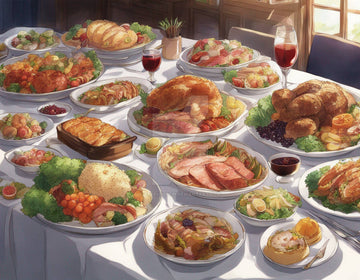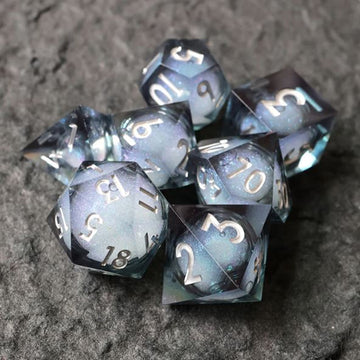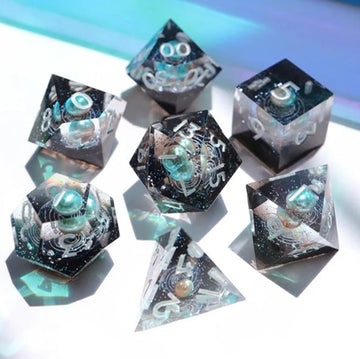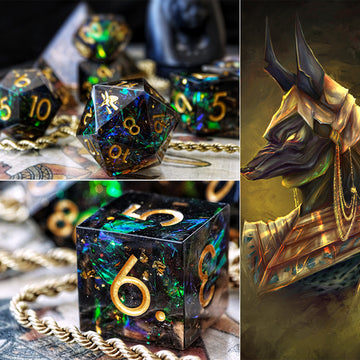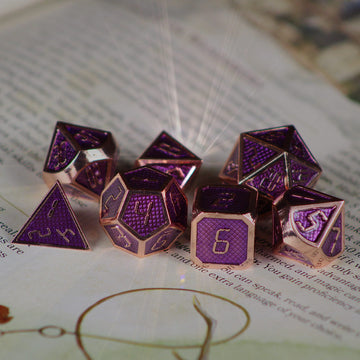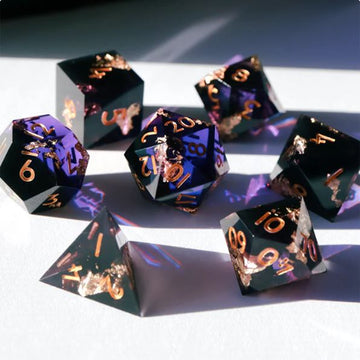How to Create Your DnD Feast Encounter in 7 Easy Steps
Plus, Pick from 5 Structure Options for Running a DnD Banquet Encounter
By Riley Rath
Title image © steelbolt31
One more post to go! Time to pair all this information on medieval banquets, feasts, and festivals with practical mechanics and guidelines for integrating them into your dnd campaigns!
Hit the following links to learn about:
- Why banquests are fun
- Medieval banquets
- Why your feast MUST feature FOOD
- NPC archetypes that should be present

© Jan Weßbecher
Step 1: Select a Reason for the Feast
Feasts are expensive; no one throws one "just because." There was no "treat-yo-self" in the medieval (and probably fantasy) world. But don't worry, because the valid feast-reasons are numerous! And just for kicks and giggles, here are the options grouped by the letter "H":
- Holy Day: A day of religious observance, often the culmination of a period of fasting or religious observance. The day has a supernatural, metaphysical purpose.
- Holiday: (Yes, this is just another version of "holy day"... sue me!) Secular holidays like independence days.
- Harvest: Could be the primary fall harvest or mini-harvests for seasonal foods.
- Hospitality: Someone important and/or beloved is visiting... so let's make them a nice meal! This is the smallest and simplest reason to throw a banquet.
- Highborn and Heirs: Birthdays of nobility or other important leaders of the region.
- Homecoming: The Lord's son has returned from crusading. Or his daughter is visiting for the first time after visiting university. Regardless, it is a celebration of a return!
- Harbinger: Is the town cursed and forced to offer up a child to a monster? Well, then in a sick, twisted way, they might hold a feast to celebrate the offered one's duty.
- Honoring: Feasts for remembering those who served, lived, or sacrificed. Think Armistice Day or Dio de los Meurtos.
Step 2: Determine Who Is Invited
Is this a feast for the nobility? Clergy? Guilds? Everyone in town? Or... if it's particularly massive... everyone in the country? This is relevant for two reasons:
A) Aesthetics: If everyone is invited, the banquet is likely being held at the religious center, town square, or in a large field. Just like in real life, the smaller the party list, the more venue options there are at your disposal.
B) The players need to know how to attend! Are they invited and brought as a guest, or do they need to sneak in? Is it expected that they partake, even if they are strangers from out of town?
Step 3: Decide if the Players Are Safe or Not
Maybe this is just my DMing style, but if you want player characters to get drunk, dance in a pretty dress without armor and weapons, or win a pie eating contest and only move at ½ their usual speed... then you need to tell them that they can reasonably assume that they are safe. If there is a chance of demonic invasion or cultic takeover, they will probably be searching for threats rather than interacting with the banquet you worked so hard to create.
Step 4: Select the Religion and Season
The time of year that your DnD banquet takes place will determine a lot. Unless you want stark contrast, the weather and season will determine what people are wearing, the colors used, if the events are inside or outside, and the food that is available.
Of course, the season of choice will depend on the region your players are adventuring in. If it's winter and you are in a place inspired by medieval Germany, then you banquet will surely take place inside. However, summer in Ottoman, Baghdad will ALSO take place inside. (Want to learn more about using dnd weather in your adventures? Check out this post!)

© Natcha Ngamtweerat
Step 5: Pick Your Food and Drink
Speaking of the food that is available... as stated in blog post #3, you gotta select the food! Be specific, evocative, and detailed! If you want, provide minor bonuses to the particularly rare or delicious menu options. Stuff like an extra d4 for a skill check, +1 temp HP, or advantage on a particular save before their next short rest.
Step 6: Create Rituals or Traditional Activities
Many feasts are going to have standard activities. Stuff like initial greetings, a toast, welcome, or prayer before the meal, singing over food, eating, dancing, etc. But depending on the reason for the feast you chose during Step 1, there may be events unique to this particular feast.
For example: "Fat Tuesday" was created on the day before Ash Wednesday (the beginning of Lent) so that all the leftover fat and butter from winter wouldn't go bad and go to waste during the 40-day fast. And many holidays like Thanksgiving are accompanied by parades down main street, home rituals (football in the backyard), and particular Turkey-related foods!
Step 7: Add Interesting NPCs
In the previous blog post, I detailed the "banquet NPC archetypes" that should be present at a feast. Select those that are appropriate for your setting and create some interesting NPCs for your players to role-play with! Make them from scratch, use a generator, or let your imagination do the heavy lifting (read my post on making an NPC in under a minute here!).

Feast Your Eyes on These 7-Dice Sets!
How to Run a DnD Banquet Encounter
Okay, so you have created a banquet for your player characters. But as I have learned over and over and over again... MAKING and RUNNING are two very different things in TTRPGs.
I cannot tell you how many interesting and unique towns I have created only to be flustered and frustrated when I realize I have provided no structure to help players explore them (YES that will be an upcoming blog post!).
Which is why here I have provided several options for structuring your DND feast encounter. They will be ordered from least structured to most structured.

© Envar Studio for Valorant
A) Give a Detailed Overview and Let Players Choose
Despite what I just said above, a banquet is different than a city. And sometimes just giving a long, detailed description and asking each player what they would like to do works just fine! I imagine this structure would work perfectly for something like Bilbo's birthday party in The Fellowship of the Ring.
However, for this to truly work and "feel right," the players have to be comfortable splitting the party. And be sure to make the description just generalized enough that there is more for you to explain and players to discover when they make their choices. For example, it wouldn't make much sense to go hang out with Merry and Pippin AFTER they already launched the dragon firework!
B) Roll Initiative (So They Can Take Initiative!)
This is basically the same thing as Option A, but with a twist! The players are still free to interact however they want, but by rolling initiative, they will subconsciously think that there is either a challenge or a conflict present as they engage with the feast. As a result, they are likely to:
- Think more critically about your descriptions
- Be more intentional with their imagination
- Become more earnest with their engagement
As the DM, you have a choice: do you plant threats or dangers in the feast that make the initiative roll necessary... or is it perfectly safe and you are just using initiative to trick their brains? Up to you!
C) Have Different NPCs Initiate and Lead
This is the middle ground between free-form and rigid structure. In this case, you give players the freedom to explore wherever they want in the banquet. But rather than letting them do whatever they want, you have an NPC "waiting" to invite over whoever heads in their direction. Obviously, this requires detailed NPCs with premeditated motivations and a personality that may be drawn to/repulsed by the player characters. If there are NPCs present with plot-/character-growth-essential missions, then this is a great place to use them.
Alternatively, rather than having NPCs always initiating, you can have players roll perception for noticing NPCs themselves.
D) Pre-Plan "Trigger" Events
With this option, after you describe the banquet, festival, or feast, you unleash players upon it like in Option A. But this time, rather than letting them interact until its conclusion, you interrupt the feast with 2 - 3 events. These can be totally normal, like a bardic performance, ballroom dance, or religious prayer and ritual. Or it can be abnormal, such as a young woman fainting from poison, a sudden fist fight between two gentlemen, or a particular dish being magically enhanced.
Regardless, the tone and opportunities at the DnD festival should SHIFT once these events take place. The idea is to add layers of depth to the whole ordeal. This allows players to revisit certain NPCs at a banquet or booths at the festival to learn more about what might be underneath the surface.
E) Provide a Structured Schedule
If Option A made the players "lone wolves," then in Option E they are a wolf pack. Keep them together the whole time: at the same table, performing the same dances, interacting with the same NPCs. Each element of the banquet they all observe and partake in simultaneously.
The benefits? Players get to observe the whole banquet, which means nothing you created gets left out. The players will stay together and feel safer, allowing them to enjoy the "downtime" of the banquet to the fullest. And by unfolding the banquet one by one, the DM can focus on narrating each aspect as it comes. The downside? Like all more structured approaches, there is less agency for players.

© Kay John Yim
AND THERE YOU HAVE IT!!!
In five blog posts, everything you need to know about banquet etiquette, invitees, feasting, and how to run your own in TTPRG/Dungeons and Dragons campaigns!
Of course, this is just a guide! If you would like to tell us about:
- Other historical facts about ancient or medieval banquets
- Your favorite fantasy foods to be present at a feast
- More NPC archetypes players can choose from
- Additional steps or structure for creating your own DnD Banquet encounter
Then we would love to hear about it! Please comment down below with your thoughts and we'll be sure to respond! Hell... if we get enough responses, we'll probably update the blog post with the top comments included!
Finally, if you enjoyed the blog post, please consider browsing our dice selection here at Awesome Dice. Because as helpful as our content is, it's not absolutely necessary like our dice!
Feast Your Eyes on These 7-Dice Sets!
Shop Now

